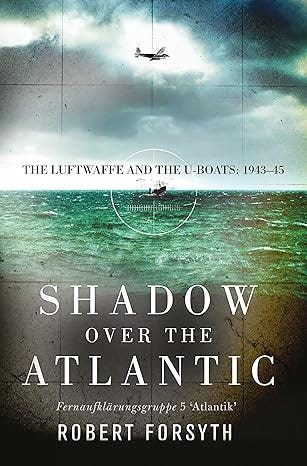Shadow Over the Atlantic: Air, Sea, and Strategic Failure
A closer look at aerial reconnaissance, U-boat tactics, and Luftwaffe missteps in Shadow Over the Atlantic
Would the Allied invasion of Normandy, France, on June 6th, 1944, have been possible if the German U-boat Wolf Packs had been more effective in sinking Allied shipping? I kept thinking about this the entire time I was reading the book.
When most people think of the Battle of the Atlantic, they picture U-boats (submarines) and convoys locked in a deadly chess match across stormy seas. This was true in many ways, but the U-boats had a major disadvantage: the Atlantic Ocean was big, and the allied convoys were hard to find without help. Robert Forsyth’s Shadow Over the Atlantic sheds light on a lesser-known player in that battle: the Luftwaffe’s aerial reconnaissance units. This deeply researched book uncovers how German aircraft scoured the Atlantic with mixed success, seeking Allied shipping while supporting U-boat wolfpacks from above.
The book focuses on the Luftwaffe’s missions from 1943 to 1945, including long-range flights from occupied France and Norway over the open ocean to search for Allied convoys. It offers a look into how Germany’s air and naval forces struggled to coordinate how aircraft were used to shadow convoys and how evolving technology and tactics by both sides shaped the outcomes.
Convoy success was an important topic, and it still is today. It is estimated that between 80% and 90% of global trade by volume is carried out via merchant shipping today, with a worldwide merchant fleet exceeding 50,000 ships. During the war for the Atlantic, over 2,000 merchant ships and ~175 warships were sunk, providing escort services or bringing supplies to Allied forces in Europe. The cost of lives was immense, with over 30,000 Merchant Seamen and several thousand naval personnel lost to the Atlantic.
Today, global shipping is stalked not by submarine wolfpacks but by land-based threats, Houthi drone and missile units in Yemen, that have disrupted Red Sea shipping routes, driving up insurance rates and forcing shippers to take longer, costlier alternate routes around Africa.
It makes you think what a future war between major powers would look like. Would they resort to unrestricted warfare on the seas, threatening the global merchant fleet? The oceans have not gotten any smaller since 1944, but the sensors for locating and tracking shipping have improved a great deal. Still, naval forces will continue to be challenged by the vastness of our oceans. Although aerial maritime reconnaissance has seen significant improvements over the past 80 years, there are still lessons to be learned from World War Two Luftwaffe operations in the Atlantic.
This book is mainly about the Luftwaffe units and crews and the various aircraft sent on reconnaissance flights across vast distances of the Atlantic Ocean, searching for Allied convoys. However, we need to start with the naval officer who commanded the U-boats and who had the insight to see the necessity of aerial reconnaissance.

Karl Dönitz (1891–1980) was a German naval officer and admiral who played a pivotal role in shaping the Kriegsmarine (Nazi Germany’s navy) during World War II, particularly through his leadership of the U-boat fleet.
Dönitz began his naval career by joining the German Imperial Navy in 1910. He emerged as the chief architect of Germany’s U-boat strategy, believing that large numbers of submarines, organized into coordinated “wolf packs”, were essential to effectively disrupt Allied convoys. Understanding the limitations of submarine reconnaissance, he strongly advocated for the integration of aerial reconnaissance to support U-boat operations. He recognized that air support would be critical in locating and targeting enemy shipping, as U-boats had limited capacity to scout large ocean areas on their own.
Key Takeaways
Poor Coordination Between Services
Keep reading with a 7-day free trial
Subscribe to The Military Reading Room - History, Strategy, and Insight to keep reading this post and get 7 days of free access to the full post archives.






